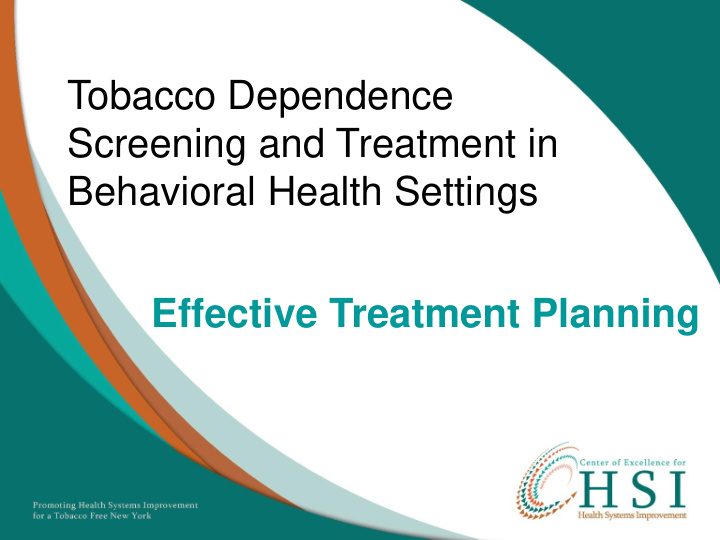



Tobacco Dependence Screening and Treatment in Behavioral Health Settings Effective Treatment Planning
OBJECTIVES As a result of this training, participants will be able to: • Identify various elements of a treatment plan and how they apply to the treatment of tobacco use • Identify treatment interventions that can be utilized in the treatment of tobacco use • Complete treatment plans that effectively address tobacco use 2
AGENDA • Welcome, Introductions, Goal and Objectives • Elements of a treatment plan • Tobacco use treatment interventions • Creating effective treatment plans for tobacco use • Closing 3
WELCOME & INTRODUCTIONS Please share your: • Name • Agency • Role 4
T REATMENT P LANNING B ASICS 5
Basis of the Treatment Plan • Based on findings in the assessment • Only areas identified as problematic are addressed • Takes into account the strengths, abilities, and preferences of the client. • Treat for as long as it takes • Developed in collaboration with the client. 6
When to Address Tobacco Use • When a client is a current tobacco user? • When the client has never used tobacco? • When the client has a history of tobacco use and last used six months ago? • When the client has a history but hasn’t used in two years? • When a client states that they don’t want to stop using tobacco? 7
Purpose of the Treatment Plan • Helps organize client treatment and therefore make it more effective • Helps to justify the provision of services to payors • Allows client to be active participant in determining what and how things will be addressed during treatment 8
Elements of a Treatment Plan • Problem Statement-Defines rationale for addressing specific area • Long-Term Goal-Represents a resolution of the problem • Short-Term Goal-Specific, measurable steps client will take to reach problem resolution • Interventions-Services counselor will provide to support short-term goal acquisition 9
Stages of Change and Treatment Planning • Pre-contemplation • Contemplation • Preparation • Action • Maintenance How does the stage of change a client is in impact the treatment planning process? 10
Stages of Change and Treatment Planning • The stage of change an individual is in with regard to tobacco will help determine which treatment interventions are appropriate 11
Stages of Change and Treatment Planning • Pre-contemplation and Contemplation – Motivational Interviewing • Preparation, Action and Maintenance – Pharmacological Interventions – Cognitive Behavioral Therapy – Relapse Prevention Therapy 12
A CTIVITY -E LEMENTS OF A T REATMENT P LAN 13
Tobacco Use Treatment Interventions • In small groups, write down as many different interventions to address tobacco that you can think of • Be as specific as possible 14
Tobacco Use Treatment Interventions • Nicotine Gum • Nicotine Lozenge • Nicotine Nasal Spray • Nicotine Patch • Nicotine Inhaler • Buproprion • Varenicline 15
Tobacco Use Treatment Interventions • Motivational Interviewing • Cognitive Behavioral Therapy • Relapse Prevention Therapy • Individual Counseling • Group Counseling • Contingency Management • Peer Recovery Support • Mindfulness 16
Case Study # 1 • Now let’s review a case study and work together to create a treatment plan addressing the tobacco use 17
Case Study # 2 • Now you will have an opportunity to complete a treatment plan for tobacco use independently 18
Case Study # 3 • Practice creating a treatment plan individually one more time using a case study 19
T HANK Y OU ! 20
Recommend
More recommend